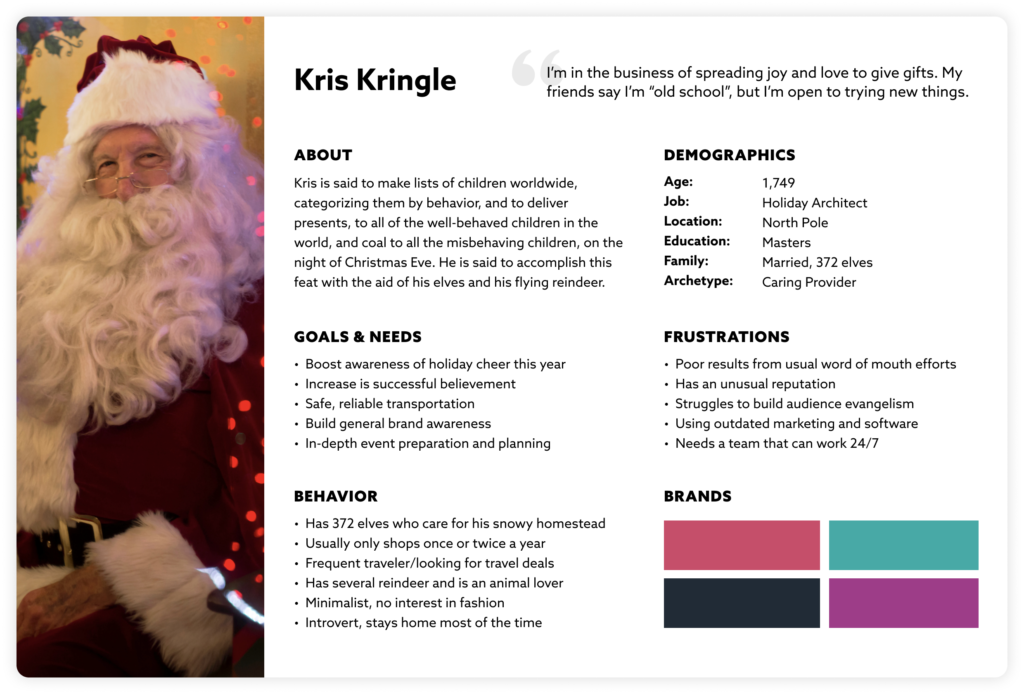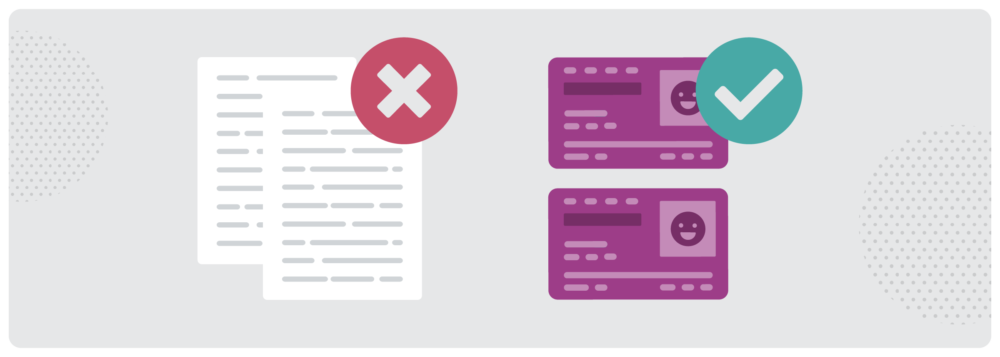What if there was a low-effort and low-cost way to paint a picture of your audience segments? What if you had profiles of your primary ICPs right at your fingertips, that both you and your team could easily reference? Sounds pretty dreamy, right? If so, then user personas are your dream come true.
A user persona is a mini profile or visual representation of your ideal audience segment. These fictional characters are often used as a reference point in your marketing and user experience strategies. We’ve already discussed in-depth the importance of knowing exactly who you’re marketing to and how keeping your audience in mind is key, and user personas support you in doing that.
So, what are user personas used for anyway? Personas are a quick way to see key information about your ICP. These usually include your ICP’s goals, needs, struggles, and demographic information. Having all that information in one place for your team to reference and guide user-focused decisions, while they craft content and strategy, is incredibly useful.
User personas help you to answer the following questions:
- Who exactly is my ideal customer?
- What are their needs, goals, or motivations?
- What are their frustrations or pain-points?
- What brands do they enjoy?
- What is the best way to communicate that we meet their needs?
In this article, we’re going to dive into how to create and implement insightful user personas. Here at Digital Reach, we know that insightful user personas lead to delightful user experiences, and that starts with research.

Digging into Research
When beginning to dig into the data, it’s important to know that user personas are a representation of a segment of your audience and not your entire audience. You wouldn’t talk to your sweet little grandma the same way you talk to your best friend, right? The same goes for your audience segments. That’s why we recommend that you already have audience segments in place, before diving into user persona creation.
Once you have your segments ready to go, start where you are. When gathering persona data on your segments, use what you have. No matter what, the key is to take the time to dig into everything you have on your segments.
Some great ways to research your segments are:
- Digging into your Google Analytics
- Doing interviews with your audience
- Conducting surveys
Because a user persona is a hypothesized representation of a group of users, it’s okay to make assumptions based on what you already know about them. There isn’t a one-size-fits-all approach to creating user personas and the most important thing is that you’re accurately depicting your segments. Once you have the nitty-gritty details about your segment, it’s time to put it all together into something tangible.
Creating a Basic User Persona
You’ve got your data and you’re ready to go! Now, it’s time to decide what elements to include in your user persona. A quick Google search will show you a wide variety of things to include in your personas, but we’re going to start with the basics. As we mentioned earlier, the goal of your personas is to reference an entire audience segment’s needs, goals, and struggles – so let’s start there. Take a look at this faux user persona we created for Santa, below.

Using the faux persona above, let’s go over the basic starting points of what you can include in your own:
Demographics
These are fictional characters after all! In order for these to feel as real or human as possible, make sure to include demographics like a photo, name, age, location, or job title. Odds are, you’re marketing to different types of people and that should be reflected in each persona. Use the research and data you gathered to come up with this.
Short Bio/About
Including a short bio about your character is another great way to make these personas feel real. You’re representing a segment of your audience, and those people have personalities and stories. Allow that to shine in a short bio.
Motivations (Goals & Needs)
We’re in the business of meeting users’ needs, so obviously this needs to be included! What are your ICP’s primary goals and needs? Determine those key desires and list them out. Including these will make sure anyone who references your persona is working to meet them.
Frustrations
Just as we need to list out their motivations, we need to list out their primary frustrations. In order to meet their needs and communicate that you solve the problems they face, you often need to understand what the frustration is at its core.
Behaviors
Us humans are complex creatures and we have plenty of reasons why we do the things we do. Including common behaviors is a simple way to open a window into the “why” behind your ICP’s decisions. For Santa, it would be pretty tough to market fashion products to him as he’s a minimalist who isn’t interested. (Please note, we did not confirm this with Santa. All Santa information is based on assumption.)
Preferred Brands
We already know how crucial competitor analysis is and it’s just as crucial to include a snapshot of this in your user personas. Doing so allows those who reference your personas to easily see what types of brands to look at when considering things like positioning, communication, or design. Knowing what type of brands a user is loyal to is useful information.
Remember, there is no right or wrong way to create your user persona. You can add to or subtract elements as you see fit. Some other common elements seen in user personas are things like archetypes, a quote, or personal mottos. Once you’ve determined and organized all of the elements you need, it’s time to beautify that data!

Implementing Your Persona
Once you have gotten all of the elements ready to go, you want to present it in an easily digestible and shareable way. That’s where persona cards come in. Take a look at the Santa user persona above. Imagine working on a strategy and getting all of the data included in Santa’s persona in the form of a messy Google Doc. Having a well-designed persona card saves your team time, keeps everything in one place, and is an opportunity for your brand to carry over internally.
As a creative, I’m obligated to say that this is when the fun stuff starts! Using your brand guides, get creative and create a user persona card layout or template that works best for you. Want sparkles? Go for it. Want to use cartoons instead of stock imagery of humans? The sky’s the limit, my friend. As long as that crucial data is being visually organized in an easy to read way and it’s on-brand, have fun! Once you’ve gotten your persona card created, it’s time to put it to work.
Here are some common situations when user personas should be used:
- Creating content for your audience
- Developing your brand’s tone/voice
- Writing brand copy or creating ads
- Creating branded landing pages or websites
- When you’re selling something
- When you’re designing something
- When you’re marketing something
- Basically, for anything that is customer-facing
Go Forth and Delight
As I mentioned earlier in this post, insightful user personas lead to delightful user experiences. Having user personas is an insightful tool for you and your team that allows anyone to know exactly who they’re targeting. Having personas right at your fingertips is a surefire way to ensure your audience is top-of-mind and the experiences your team creates are tailored.
In need of robust user personas? Skip the DIY and let us help.




